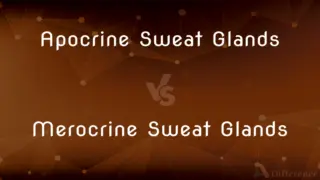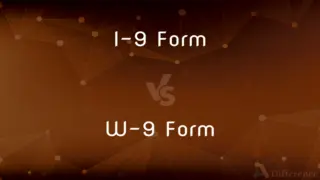FHD vs. LED — What's the Difference?
Edited by Tayyaba Rehman — By Fiza Rafique — Published on December 31, 2023
FHD (Full High Definition) refers to a display resolution of 1920x1080 pixels; LED (Light Emitting Diode) is a technology used for display backlighting or illumination.

Difference Between FHD and LED
Table of Contents
ADVERTISEMENT
Key Differences
FHD and LED are terms commonly associated with display technology, though they refer to different aspects. FHD stands for Full High Definition, and it is a resolution specification that means a screen displays 1920 pixels horizontally by 1080 pixels vertically. On the other hand, LED represents Light Emitting Diode, which is a type of technology used to produce light in various applications, including as a backlight source for screens.
When looking at screens or monitors, FHD is often one of the resolutions consumers might encounter. It provides a crisp and clear picture, suitable for many viewing experiences, from movies to gaming. Conversely, LED does not determine the clarity or sharpness of a screen's display. Instead, LED refers to the method by which the screen is lit up, ensuring that content is visible to the viewer.
In terms of advancements, FHD was a significant step up from earlier standard resolutions, offering viewers a richer visual experience. As technology continues to evolve, there are resolutions even higher than FHD, like 4K and 8K. In contrast, LED technology, replacing older technologies like CCFL (Cold Cathode Fluorescent Lamp) for backlighting, offers benefits such as better energy efficiency and a potentially slimmer screen design.
It's essential to recognize that FHD and LED can coexist in the same product. A screen can be FHD in terms of its resolution and also utilize LED technology for its backlighting. In this case, a consumer gets the combined advantages of both: the clarity of Full High Definition and the energy efficiency of Light Emitting Diodes.
Comparison Chart
Definition
Display resolution of 1920x1080 pixels
Light Emitting Diode technology
ADVERTISEMENT
Main Function
Determines screen clarity and sharpness
Provides illumination or backlighting
Application
Refers to screen resolution
Used in various light-producing applications
Evolution
Progressed from standard resolutions to higher ones
Replaced older backlight technologies like CCFL
Coexistence
Can exist without LED backlighting
Can backlight any screen, irrespective of resolution
Compare with Definitions
FHD
Common resolution for many modern screens and monitors.
Most laptops in the store come with an FHD display as standard.
LED
More energy-efficient than some older lighting technologies.
I replaced all my bulbs with LED ones to save on electricity.
FHD
A display resolution of 1920x1080 pixels.
The new TV boasts an FHD screen for clear visuals.
LED
Commonly used for screen backlighting.
My new TV has an LED backlight for vibrant colors.
FHD
A step up from standard definition resolutions.
Transitioning to an FHD monitor improved my gaming experience.
LED
Stands for Light Emitting Diode.
The flashlight uses LED technology for brighter light.
FHD
Ensures a detailed and sharp viewing experience.
The difference between standard definition and FHD is quite noticeable.
LED
Offers a longer lifespan than traditional bulbs.
The LED lights in my garden have lasted for years.
FHD
Represents Full High Definition in displays.
I prefer watching movies on an FHD screen for better clarity.
LED
Utilized in various applications, from screens to indicators.
The charging indicator is a tiny LED that turns green when full.
LED
A semiconductor diode that converts applied voltage to light and is used in lamps and digital displays.
LED
Past tense and past participle of lead1.
LED
Simple past tense and past participle of lead
LED
Under somebody's control or leadership.
LED
Of a farm, etc.: managed by a deputy instead of the owner or tenant in person.
LED
Of Lead.
LED
Diode such that light emitted at a p-n junction is proportional to the bias current; color depends on the material used
Common Curiosities
What does FHD stand for?
FHD stands for Full High Definition, representing a resolution of 1920x1080 pixels.
Can a 4K TV use LED technology?
Yes, a 4K TV can use LED technology for backlighting.
Does FHD determine a screen's brightness?
No, FHD refers to resolution. Brightness is influenced by backlighting, often provided by LEDs.
Is FHD better than standard definition?
Yes, FHD offers clearer and sharper visuals compared to standard definition.
How does FHD compare to 4K?
4K has a higher resolution (3840x2160 pixels) and offers even more detail than FHD.
What is the main purpose of LED in screens?
In screens, LED primarily provides backlighting, making the display content visible.
Why are LED lights considered energy-efficient?
LEDs consume less power and produce more light per watt than many traditional lighting methods.
Can a screen be FHD without LED backlighting?
Yes, a screen's resolution (like FHD) is independent of its backlighting technology.
What's the difference between LED and OLED in terms of displays?
LED uses diodes for backlighting, while OLED (Organic LED) has self-emitting diodes, eliminating the need for backlighting.
Is FHD suitable for gaming?
Yes, FHD provides a clear and detailed display, making it suitable for gaming.
Are there resolutions higher than FHD?
Yes, there are resolutions like 4K, 8K, and even higher.
What are the benefits of LED backlighting in screens?
LED backlighting offers energy efficiency, potential for slimmer designs, and consistent brightness.
Do LEDs wear out over time?
LEDs have a long lifespan but can degrade over extended periods, leading to reduced brightness.
Is every FHD screen also LED-backlit?
Not necessarily; while many modern FHD screens use LED backlighting, the resolution and backlighting technology can be independent of each other.
In what other applications are LEDs commonly used?
Beyond screens, LEDs are used in flashlights, indicators, traffic lights, and general lighting.
Share Your Discovery

Previous Comparison
Sigma vs. Pi Bond
Next Comparison
Entity in DBMS vs. Relationship in DBMSAuthor Spotlight
Written by
Fiza RafiqueFiza Rafique is a skilled content writer at AskDifference.com, where she meticulously refines and enhances written pieces. Drawing from her vast editorial expertise, Fiza ensures clarity, accuracy, and precision in every article. Passionate about language, she continually seeks to elevate the quality of content for readers worldwide.
Edited by
Tayyaba RehmanTayyaba Rehman is a distinguished writer, currently serving as a primary contributor to askdifference.com. As a researcher in semantics and etymology, Tayyaba's passion for the complexity of languages and their distinctions has found a perfect home on the platform. Tayyaba delves into the intricacies of language, distinguishing between commonly confused words and phrases, thereby providing clarity for readers worldwide.














































